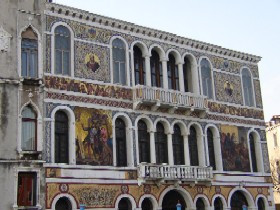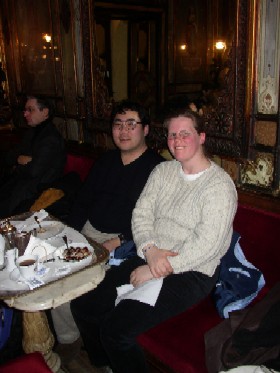Venice is a city of canals and bridges, all connected together into an immense, human Habitrail. The only way to get around town is either in a boat or on foot. The tourist map we bought turned out to be useful, not so much because it kept us from getting lost (inevitable) but because it showed us we weren't as lost as we thought, and we covered a lot more ground than we expected we would.
 Rialto Bridge is one of the three bridges which cross the Grand Canal, the central waterway that winds like a snake through the heart of the island. As one of the major bottlenecks of pedestrian traffic, it also makes for a great place to locate souvenir shops and restaurants catering to tourists, so we didn't really spend much time here other than as a way to get from Point A to Point B.
Rialto Bridge is one of the three bridges which cross the Grand Canal, the central waterway that winds like a snake through the heart of the island. As one of the major bottlenecks of pedestrian traffic, it also makes for a great place to locate souvenir shops and restaurants catering to tourists, so we didn't really spend much time here other than as a way to get from Point A to Point B.
 St. Mark's Basilica stands at one end of the square of the same name, and is one of the grandest of the zillions of churches Venice boasts. More Renaissance-era mosaics adorn her inside and out, and the central frieze is topped with four horses, replicas of Greek or Roman bronze figures housed inside the church that were orignally found in Constantinople in the 11th Century, stolen and brought to Venice, stolen again by Napoleon, and returned to Venice in the late 1800's.
St. Mark's Basilica stands at one end of the square of the same name, and is one of the grandest of the zillions of churches Venice boasts. More Renaissance-era mosaics adorn her inside and out, and the central frieze is topped with four horses, replicas of Greek or Roman bronze figures housed inside the church that were orignally found in Constantinople in the 11th Century, stolen and brought to Venice, stolen again by Napoleon, and returned to Venice in the late 1800's.
 Caffe Florian is located on the ground level of the Doge's Palace, which offers storefront space to a number of posh establishments. Florian opened its doors in 1720, and was the first place in Venice to serve coffee. Over the centuries of continuous operation, the tables of Caffe Florian have been graced by the patronage of such names as Dickens, Byron, and Proust, and were rich hunting grounds for that epitome of chastity and moderation, Cassanova. Yes, THAT Cassanova.
Caffe Florian is located on the ground level of the Doge's Palace, which offers storefront space to a number of posh establishments. Florian opened its doors in 1720, and was the first place in Venice to serve coffee. Over the centuries of continuous operation, the tables of Caffe Florian have been graced by the patronage of such names as Dickens, Byron, and Proust, and were rich hunting grounds for that epitome of chastity and moderation, Cassanova. Yes, THAT Cassanova.
|
 Ah, yes, the romance of a gondola ride. We learned that you need to shop for a gondolier before choosing to ride one of these sleek beauties, because not all of them are particularly chatty. Still, for about $80, we got a 45-minute tour of the side canals and little-seen corners of Venice. And if you go in mid-March like we did, wear a good coat. Bring a hat. And gloves...
Ah, yes, the romance of a gondola ride. We learned that you need to shop for a gondolier before choosing to ride one of these sleek beauties, because not all of them are particularly chatty. Still, for about $80, we got a 45-minute tour of the side canals and little-seen corners of Venice. And if you go in mid-March like we did, wear a good coat. Bring a hat. And gloves...
 Many of the buildings in Venice have stood since the Renaissance, and colorful mosaics adorn many facades along the Grand canal. Elsewhere, you can see Turkish-inspired architecture, with more pointed arches and taller columns, and elaborate homes that exemplify the wealth and ostentation of 17th and 18th Century Venetian life..
Many of the buildings in Venice have stood since the Renaissance, and colorful mosaics adorn many facades along the Grand canal. Elsewhere, you can see Turkish-inspired architecture, with more pointed arches and taller columns, and elaborate homes that exemplify the wealth and ostentation of 17th and 18th Century Venetian life..
 The bells of the Campanile seem to ring at random times; near as we could figure, they rang to announce the beginning and end of mass. The view from the top is impressive, however, though it was odd to note that you couldn't actually see the canals from up there; the height of the buildings and the angle at which you looked at them blocked out all but the a few short stretches of the Grand Canal, so it looked like any other Italian city from up there...
The bells of the Campanile seem to ring at random times; near as we could figure, they rang to announce the beginning and end of mass. The view from the top is impressive, however, though it was odd to note that you couldn't actually see the canals from up there; the height of the buildings and the angle at which you looked at them blocked out all but the a few short stretches of the Grand Canal, so it looked like any other Italian city from up there...





 < <
|




 < <
|
 Rialto Bridge is one of the three bridges which cross the Grand Canal, the central waterway that winds like a snake through the heart of the island. As one of the major bottlenecks of pedestrian traffic, it also makes for a great place to locate souvenir shops and restaurants catering to tourists, so we didn't really spend much time here other than as a way to get from Point A to Point B.
Rialto Bridge is one of the three bridges which cross the Grand Canal, the central waterway that winds like a snake through the heart of the island. As one of the major bottlenecks of pedestrian traffic, it also makes for a great place to locate souvenir shops and restaurants catering to tourists, so we didn't really spend much time here other than as a way to get from Point A to Point B.
 St. Mark's Basilica stands at one end of the square of the same name, and is one of the grandest of the zillions of churches Venice boasts. More Renaissance-era mosaics adorn her inside and out, and the central frieze is topped with four horses, replicas of Greek or Roman bronze figures housed inside the church that were orignally found in Constantinople in the 11th Century, stolen and brought to Venice, stolen again by Napoleon, and returned to Venice in the late 1800's.
St. Mark's Basilica stands at one end of the square of the same name, and is one of the grandest of the zillions of churches Venice boasts. More Renaissance-era mosaics adorn her inside and out, and the central frieze is topped with four horses, replicas of Greek or Roman bronze figures housed inside the church that were orignally found in Constantinople in the 11th Century, stolen and brought to Venice, stolen again by Napoleon, and returned to Venice in the late 1800's.
 Caffe Florian is located on the ground level of the Doge's Palace, which offers storefront space to a number of posh establishments. Florian opened its doors in 1720, and was the first place in Venice to serve coffee. Over the centuries of continuous operation, the tables of Caffe Florian have been graced by the patronage of such names as Dickens, Byron, and Proust, and were rich hunting grounds for that epitome of chastity and moderation, Cassanova. Yes, THAT Cassanova.
Caffe Florian is located on the ground level of the Doge's Palace, which offers storefront space to a number of posh establishments. Florian opened its doors in 1720, and was the first place in Venice to serve coffee. Over the centuries of continuous operation, the tables of Caffe Florian have been graced by the patronage of such names as Dickens, Byron, and Proust, and were rich hunting grounds for that epitome of chastity and moderation, Cassanova. Yes, THAT Cassanova.
 Ah, yes, the romance of a gondola ride. We learned that you need to shop for a gondolier before choosing to ride one of these sleek beauties, because not all of them are particularly chatty. Still, for about $80, we got a 45-minute tour of the side canals and little-seen corners of Venice. And if you go in mid-March like we did, wear a good coat. Bring a hat. And gloves...
Ah, yes, the romance of a gondola ride. We learned that you need to shop for a gondolier before choosing to ride one of these sleek beauties, because not all of them are particularly chatty. Still, for about $80, we got a 45-minute tour of the side canals and little-seen corners of Venice. And if you go in mid-March like we did, wear a good coat. Bring a hat. And gloves...
 Many of the buildings in Venice have stood since the Renaissance, and colorful mosaics adorn many facades along the Grand canal. Elsewhere, you can see Turkish-inspired architecture, with more pointed arches and taller columns, and elaborate homes that exemplify the wealth and ostentation of 17th and 18th Century Venetian life..
Many of the buildings in Venice have stood since the Renaissance, and colorful mosaics adorn many facades along the Grand canal. Elsewhere, you can see Turkish-inspired architecture, with more pointed arches and taller columns, and elaborate homes that exemplify the wealth and ostentation of 17th and 18th Century Venetian life..
 The bells of the Campanile seem to ring at random times; near as we could figure, they rang to announce the beginning and end of mass. The view from the top is impressive, however, though it was odd to note that you couldn't actually see the canals from up there; the height of the buildings and the angle at which you looked at them blocked out all but the a few short stretches of the Grand Canal, so it looked like any other Italian city from up there...
The bells of the Campanile seem to ring at random times; near as we could figure, they rang to announce the beginning and end of mass. The view from the top is impressive, however, though it was odd to note that you couldn't actually see the canals from up there; the height of the buildings and the angle at which you looked at them blocked out all but the a few short stretches of the Grand Canal, so it looked like any other Italian city from up there...
